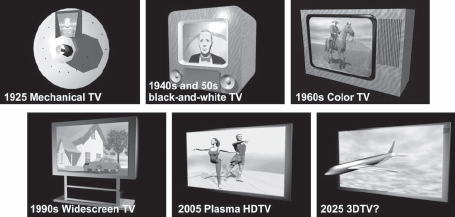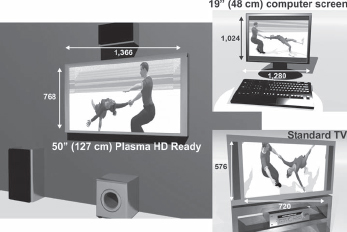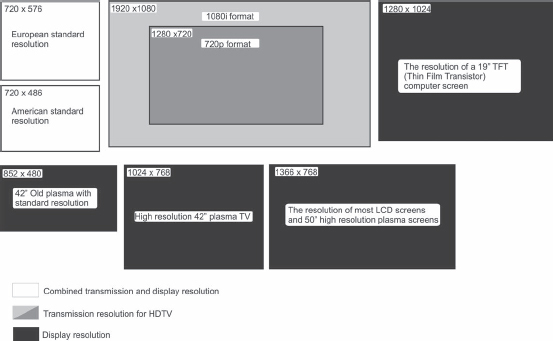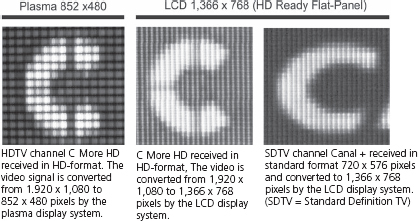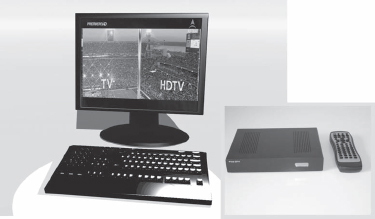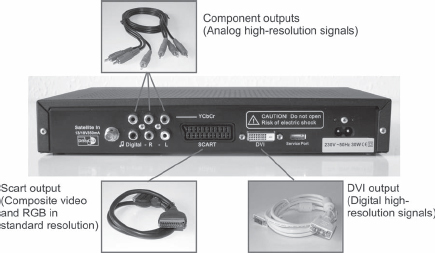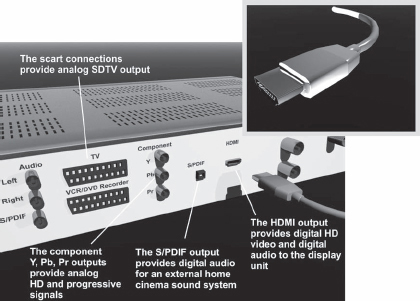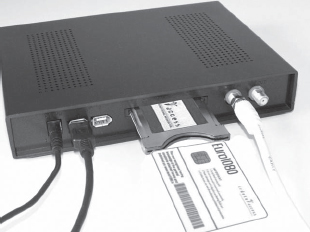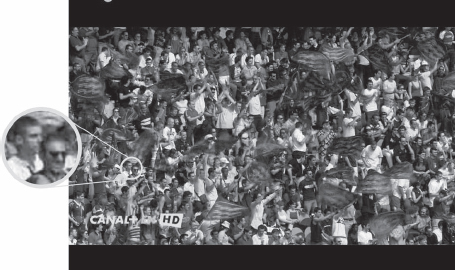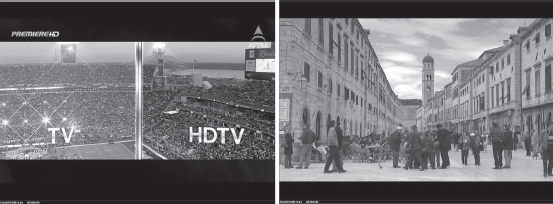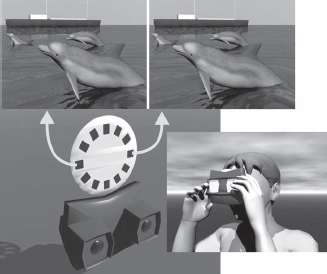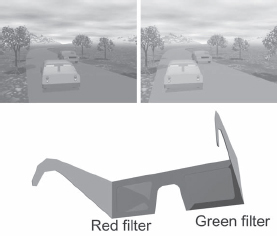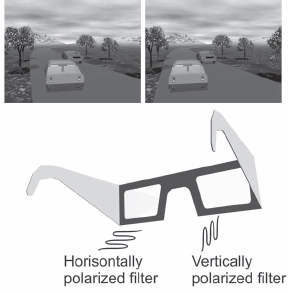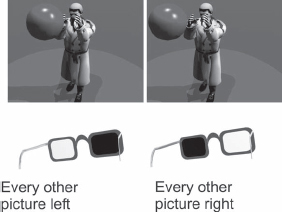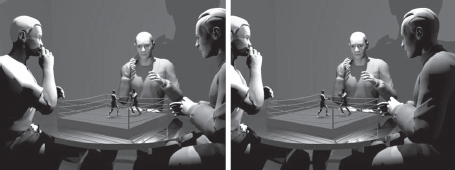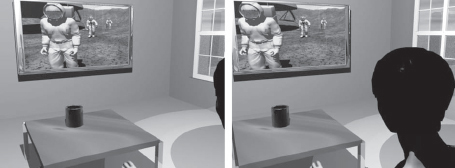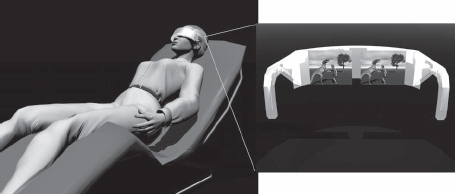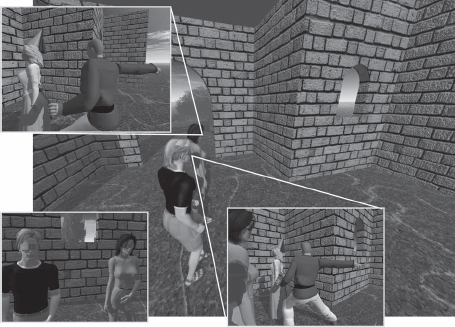12 |
HDTV and the Future of Television |
| CHAPTER |
The Home Cinema is the latest contribution on the road towards an improved way of storytelling. Having a cinema with multi-channel sound and a large screen at home provides a very strong television experience.
TV media has evolved in two directions since its inception. The first is an increased number of channels, provided by satellites and other improved distribution media. Both the quantity of content and the geographical coverage of the channels have increased considerably. In recent years, television development has focused on quality. The change has been toward providing a larger and stronger presence and experience to the viewer.
FIGURE
12.1
Since the dawn of television the goal has always been to be able to provide a larger and more detailed picture.
HIGH DEFINITION TV (HDTV)
The ideas about increasing the resolution of the TV pictures have been around for a long time. The intention of HDTV was from the beginning to increase the resolution by a factor of four. In principle, this would give the viewer the possibility to sit at half the distance from the screen and then double the picture size in the field of vision.
Figure 12.2 shows some of the most common screen sizes. Standard TV in Europe has 576 horizontal lines, each consisting of 720 pixels (In North America, it is 486 lines also consisting of 720 pixels each). Most LCD and larger plasma screens are capable of displaying 1,366 x 768 pixels, which does not correspond with the resolution in the transmitted signals. Computer screens are really high resolution displays. A 48-cm (19-inch) computer screen usually has a resolution of 1,280 x 1,024 pixels.
FIGURE
12.2
Comparing common screens and resolutions. (See color plate.)
By the 1980s, an analog HDTV system was introduced in Japan. This system was based on 1,125 lines, of which 1,035 lines are active in vertical resolution. It used an analog compression system called MUSE to make it possible to distribute the high resolution signal by means of the technology available at the time.
In Europe in the early 1990s, a HDTV standard based on 1,250 lines (including 1,080 active lines) was proposed. This would facilitate conversion to/from the European 625 line SDTV (Standard Definition Television) system since it was simply a matter of doubling the number of lines.
In 1992, when the Olympic Games were held in Barcelona, a final desperate attempt was made to introduce HDTV based on the analog MAC system. However, this also failed and HDTV was dead in Europe for many years to come.
New advances in the picture processing technology have made it quite easy to convert between any numbers of lines. Therefore a wide range of new system standards has evolved and HDTV has recently become quite successful in the United States and Japan. Some of these new systems are really more or less improvement of the existing SDTV system. One such example is the 480 line system with progressive scanning. The number of active lines in the North American 525 line system is 488. However the most commonly used HDTV system in the United States is the 1080i system based on a frame rate close to 60 Hz. As we will see, the most common systems in Europe will be the already existing 1080i system with 50 Hz frame rate and the coming 720p/50Hz system.
Interlaced and Progressive Scanning
Before we dig deeper into the various HDTV systems available today, we need to look closer at the principles of scanning a TV picture. As discussed in Chapter 1, conventional TV is based on interlaced scanning—the picture is split up in two frames, each containing every other line of the picture.
This concept is good as long as the picture does not contain too much movement. However, as seen in Figure 12.3, there will be “weaving” destroying the sharpness of vertical contours, if the objects in the picture move too much in the horizontal direction between two frames.
In progressive scanning, the lines are drawn right after each other. In addition to providing more stable vertical contours, this is also much better from a compression point of view. Modern kinds of display systems, like plasma displays and video projectors, can also provide a more stable picture when operating in progressive mode. More advanced DVD players also produce progressive scan signals that are intended to feed these kinds of displays.
FIGURE
12.3
Fast horizontal movement in interlaced scanned images will cause weaving effects. (See color plate.)
Picture Resolution
An interesting point is that for several years, most plasma displays sold in Europe had 480 lines of vertical resolution. This is quite strange since the number of active lines in the European system is 576 lines. Thus a plasma screen with standard resolution will provide fewer lines than is the case in an ordinary European CRT TV set. However, because the plasma screens are all manufactured in the same factories in Asia and it is simple to convert the signals from one line standard to another, the industry prefers to have the same kind of screens in Europe as in North America. So, for the first time, Europeans had to accept American vertical resolution in their TV sets.
However a plasma screen of this kind has one advantage. The horizontal resolution is 852 pixels, which corresponds to horizontal resolution expected when the vertical resolution is 480 pixels and the aspect ratio is 16:9. The 852 pixels of horizontal resolution are better than the standard TV widescreen format which only has a horizontal resolution of 720 pixels (see Figure 12.4).
However 480 line progressive scan television is not really HDTV. Instead it is some kind of enhanced standard television.
Today nobody speaks about the old 1,250 line or the 1,125 line systems. Instead it is either 720 progressive lines (called 720p) or 1,080 lines with interlaced scanning (called 1,080i) that have become the two systems of choice that will become worldwide standards. However, since North American systems are based on 60 Hz and European are 50 Hz, there will still be a difference in the regions. The 1,080i/50 Hz system is already used by some satellite TV channels in Europe.
FIGURE
12.4
In conventional standard resolution widescreen TV sets, the pixels are “stretched” to form the widescreen 16:9 picture. Even the 4:3 picture has “stretched” pixels since a 4:3 aspect ratio picture would have needed 768 horizontal pixels to keep the same resolution horizontally as vertically.
It is interesting to have a look at Figure 12.5 before buying a display system. The majority of HD displays of today have 1,366 x 768 pixels in resolution. As a result, a 1,080i signal can not be displayed in full resolution.
FIGURE
12.5
In HDTV, the transmission systems do not have the same resolution as the display systems. The pictures always have to be scaled to the resolution of the screen.
This might also be one of the reasons why many program companies consider the 720p format since the advantages in using progressive scanning might be better than using 1,080 lines of resolution, which almost nobody can use anyhow. But progressive scanning is supported by all HD Ready sets.
Figure 12.6 compares the resolution in the picture observed at a detail level using the logo from C More HD from Canal Digital. It is obvious that the 852 x 480 plasma is quite limited when it comes to handling the 1,080i signal. The 1,366 x 768 pixel LCD takes care of this in a much better way. To the right, there is a letter “C” from a standard resolution picture from the same program provider on the same 1,366 x 768 pixel screen and in the same scale. It is obvious that the limitation now is the resolution of the incoming standard definition signal.
FIGURE
12.6
Comparisons at pixel level between different screen resolutions and different signal resolutions (detail screenshots from Scandinavian pay TV operator Canal Digital channels C More HD and Canal+). (See color plate.)
The “HD Ready” Standard
In preparation for HDTV, all TV sets and display systems sold in Europe that meet the standards for HDTV have an HD Ready logo on their packaging. The requirements for a display to be regarded as “HD Ready” have been set by EICTA, The European Information & Communications Technology Industry Association.
A display system that is HD Ready must provide at least 720 lines of vertical resolution. It must be able to receive signals that are 720p as well as 1080i. There must be analog component inputs, Y, Pb, Pr, and either a DVI or HDMI connector for digital video.
Finally the set must be ready for high definition copy protection (HDCP).
PRACTICAL ASPECTS OF RECEIVING HDTV
Several of the pictures in this chapter are screen captures from promotional HDTV channels in Europe. These signals have been received using a computer-based satellite receiver from the Austrian company Digital-Everywhere. This unit belongs to the first generation of HDTV satellite receivers and can also receive conventional MPEG-2, DVB-S signals.
This is the same kind of satellite signals that is used for standard definition digital TV channels. As a result, the bitrate will increase by a factor of four compared to the standard definition signals. This also requires quite a lot of processing power. A 3.2 GHz Intel processor will have to work hard to cope with the 16 Mbit/s MPEG-2 bitstream that is provided by the FireDTV set-top box. This also means that the processing power of an HDTV receiver is much larger than in a conventional standard definition receiver.
FIGURE
12.7
The computer is a good way of receiving HDTV because its screen is highly resolved and quite suitable for HDTV
HDTV CONNECTORS
HDTV means new interfaces. The scart connectors that have been in use in Europe for 25 years only work for standard definition signals. Therefore some new connectors are introduced when starting to use high definition TV receivers. However all HDTV receivers also down-convert the high definition signals to interface with standard definition TV sets, video recorders and DVD recorders. For this reason the scart outputs will hang around for many years to come.
There are 3 standard ways of bringing high definition signals to the display system: analog, digital and a new technology, high definition multimedia interface.
The analog way uses the component outputs of the HDTV receiver. This is the same kind of outputs, fitted with RCA connectors, that have been used to connect DVD players to enable progressive scan in the standard definition format.
However it is far better to use a digital connection between the receiver and the display system. In the first generation of HDTV receivers (see Figures 12.8 and 12.9), the digital video interface (DVI) connector is quite common in more advanced computer graphics cards.
FIGURE
12.8
The first generation of HDTV receivers included a variety of connection options to interface with different kinds of display devices.
Scaling the video between different resolutions takes time in flat-panel display processors. If the receiver is connected to an external home cinema amplifier, this delay can cause lip sync problems. Delaying the S/PDIF audio output signal from the receiver compensates for this. In the menu system in Figure 12.10 there is a setting between 0-200 milliseconds. As an alternative there are home cinema amplifiers that have similar built-in audio delay features.
If you just use the internal audio system of the flat-panel display, you will not have any lip sync problems since the flat-panel takes the delay into account when processing the audio.
FIGURE
12.9
The Force 505SHD-SD MPEG-2 DVB-S receiver (OEM product from Emitor) is an example of the first generation European HDTV receivers. It has a DVI interface as well as component outputs and a common interface slot for CA modules.
FIGURE
12.10
The HDTV receiver menu offers a number of video output alternatives. There is also an audio delay feature. (Screenshot from C More HD, Canal Digital combined with the menu system from Force 505SHD-SD).
THE HIGH DEFINITION MULTIMEDIA INTERFACE, HDMI
In the long run, there is a new interface which soon will be as common as the scart connector. It is the high definition multimedia interface (HDMI) connector. It is a slim device that can handle the high definition digital video signals and also the digital multi-channel audio that is an important ingredient in any home cinema system. Of course, the use of HDMI for audio as well requires some kind of integrated multi-channel audio system. The separate S/PDIF connection for digital multi-channel audio will be with us for many more years to come and will still make connection to an external sound system possible.
DVI and HDMI are compatible. By using a conversion cable you can connect HDMI interfaces to plasma TVs or other display systems with a DVI interface. Even in the future there will probably also be analog RCA connections for component video (Y, Pb, Pr) that carry high resolution video.
FIGURE
12.11
HDTV receivers now include a new connection for the video—either a DVI connector or an HDMI.
FIRST GENERATION HDTV TRANSMISSIONS IN EUROPE
The pioneer in HDTV in Europe was Euro 1080, later was renamed HD-1 and a second channel HD-2 was added along with a promotional channel HD-5. The station used MPEG-2 DVB-S signals to feed their 1,080i transmissions throughout Europe. Today this is a pay TV service, and it is possible to subscribe to the channel through 2010 with a one-time payment. The channel uses the Irdeto CA system and a receiver with Irdeto integrated may be used. Otherwise, an HDTV receiver with a common interface and an Irdeto CA module may be used. The previously mentioned FireDTV has a common interface, which is quite rare in computer-based digital TV reception systems (see Figure 12.12).
FIGURE
12.12
The Austrian FireDTV HDTV MPEG-2 DVB-S receiver for computers can be fitted with a CA module for HD-1 and the other channels from the same program company.
Another pioneer in the Scandinavian countries, Canal Digital, introduced the C More HD which was one of the first HDTV premium movie channels in Europe.
FIGURE
12.13
Euro1080, the pioneer in HDTV in Europe, now known as HD-1 (Screenshot from Euro1080, made before the channel name changed to HD 1; today there are also channels HD 2 and HD 5).
FIGURE
12.14
MPEG-2/DVB-S HDTV promotional transmission received from French pay TV operator Canal Plus. Sports events with audience pictures become more believable than ever before. Check the resolution in the enlarged part of the received picture from Canal Plus (Screenshot from Canal Plus, France). (See color plate.)
FIGURE
12.15
In Europe the first HDTV transmissions started in the MPEG-2/DVB-S format. (Screenshot from promotional MPEG-2 HDTV transmission from SES-Astra).
Second Generation HDTV Transmissions and Receivers in Europe
HDTV started up on satellite in Europe as 1,080i MPEG-2 transmissions using the same DVB-S standard as for the standard definition channels. The problem in using these systems is the high bitrate needed. Instead of four or five Mbit/s, as for a standard resolution channel, the bitrate end up at 16 Mbit/s, which means that only two HDTV channels can be housed in one transponder with a total capacity of 38 Mbit/s.
Therefore first-generation HDTV digital receivers are already being replaced by MPEG-4 boxes. The goal of using MPEG-4 (H.264/AVC, Advanced Video Coding) is to reduce the bandwidth consumption to about half of what is required for MPEG-2.
However the new MPEG-4 standard has proved quite hard to implement, especially real-time encoding needed for live transmissions. However in the long run, MPEG-4 is a necessity to handle the balance between providing improved picture quality and maintaining reasonable cost for transmission. It should also be remembered that the program providers will have to use dual transmission formats for many years before the standard definition transmissions may be closed. Dual transmission costs lots of money.
In addition to the improvements that can be achieved using MPEG-4, the new DVB-S2 standard, with improved error correction, will increase the bitrate that can be handled in one transponder from about 38 Mbit/s to close to 50 Mbit/s. The sum of these improvements will probably make it possible to put four or maybe five HDTV channels in each transponder. But it will take some years before this is a reality.
The German pay TV operator Premiere and the German commercial channels Sat 1 and ProSieben already use the combination of MPEG-4 and DVB-S2. Although it has been hard getting components for the production of the second-generation set-top boxes, it is for sure that these German channels have shown the way for the continued introduction of HDTV in Europe.
FIGURE
12.16
German pay TV operator Premiere was among the first to start DVB-S2 MPEG-4 based transmissions in Europe as the commercial German channels Sat 1 and ProSieben. (These screenshots are from promotional HDTV transmissions from SES-Astra, including Sat 1 HD, ProSieben HD and Premiere HD Sport).
At the time I write this book (summer, 2006) BSkyB (British Sky Broadcasting) also has HDTV transmissions that meet the MPEG-4 DVB-S2 standard. The BBC also has an MPEG-4 DVB promo satellite channel on air. However, due to lack of components, it's been hard so far for the Europeans to get hold of MPEG-4 receivers.
Today the need for HDTV is increasing in Europe, as in the rest of the world where large, flat-panel displays are getting popular. Really the bitrates used in standard television digital MPEG-2 based systems are based on the fact that the viewer uses a traditional maximum 32” cathode ray tube TV set. When the flat-panel TV sets were introduced it became obvious that there was a demand for better signal quality. HDTV is the route to go for the program companies to handle this new generation of larger and more demanding TV sets.
HDTV RECORDING
But there is a big complexity in moving to HDTV. People have several TV sets and very new standard resolution boxes in their homes. Even though it may seem very simple to record HDTV files on the hard disc a computer using devices like the FireDTV, it is not as easy to replace the conventional video recorder or DVD recorder. Of course, I can record the files on conventional recordable DVDs but the result is only about 30 minutes of recording on one disc when recording an MPEG-2 transmission at a bitrate of 16 Mbit/s.
You will need to have new recording devices that can handle the HDTV signals. Of course the easiest way to store HDTV is on a hard disc integrated in the digital HDTV receiver, in the same way as in a conventional standard resolution receiver. However permanent storage using removable discs is more difficult. It is here where the new Blu-Ray and HD-DVD formats for high resolution recording come in.
TELEVISION OF THE FUTURE
Regardless of the challenges and new technology required, HDTV will certainly be the big thing in the coming years, for home cinemas. How long it will take before all TV sets are changed into HDTV systems is hard to say, and maybe it will never happen. There might just be a market for different quality levels of television. But no doubt HDTV will be important.
What will happen after that?
The next natural next step is probably three-dimensional television. If what has been discussed in this book so far is the natural development of the TV media, 3D TV will be the ultimate challenge. It is also the technology that provides the most extensive possibilities as soon as its technical and commercial challenges have been conquered.
The human way of experiencing three dimensions is based on binocular viewing, which enables us to judge distances to objects. For this reason we have two eyes, but our eyes do not see exactly the same view. Objects that are far away are rendered quite alike by both eyes while closer objects seem to be at different locations in relation to the background. This can be seen in the Figure 12.17, which shows a stereo pair of pictures.
FIGURE
12.17
The stereo pair of picture on top can be experienced as a three dimensional picture if you focus at a distant and then quickly look down in the book with-out defocusing. (See color plate.)
The brain has the ability to provide an illusion of depth from these two pictures. The larger the differences, the closer the objects. We do not experience an exact picture of reality but rather an illusion created by our brains based on the signals we get through our eyes. And in reality, television and movies are based on a series of illusions. It is a matter of cheating the brain to make believe that we see what we see. We have seen several examples of this earlier in this book.
In order to experience a stereo pair of pictures as a 3D picture without any special glasses and devices, try to focus on a distant object. Then look straight into the book at the stereo pair in Figure 12.17. Each eye will then focus on one of the pictures respectively and a third picture will occur in between the others as is shown in Figure 12.18. This picture is a three-dimensional picture created in the brain from the two original pictures. Some training will help you to experience the other stereo pair of pictures that are shown in this chapter.
If you have problems experiencing the 3D effect, try using a piece of paper between your eyes to force them to look at one picture each.
It is quite clear that it is not easy to create a commercial product from 3D pictures. In the 1950s, the first attempts at 3D movies were made and it has been tried several times since. This is not a new invention. The most successful 3D product ever is probably the View Master, in Figure 12.19. The View Master is a modernization of the nineteenth century 3D viewing devices for still pictures.
FIGURE
12.18
The 3D image will appear directly between the two original images that represent the left and the right image channels.
FIGURE
12.19
The View Master is one of few 3D products with commercial success.
3D Movies
During the 1950s, 3D movies where shown in the cinemas. In those days colored filters were used to separate the right and left picture channels. Red and green pictures were projected on the screen and the audience wore glasses with a red filter on one eye and a green filter on the other (see Figure 12.20). This has also been tested on television using color TV to carry the green and red picture channels. In the early 1980s, old movies from the 1950s were shown in Sweden in 3D in this way. The red and green glasses were sold everywhere.
FIGURE
12.20
The first 3D movies used color filters on the projector's cinema audiences. (See color plate.)
3D Color Movies
One reason 3D movies were not a big hit in the 1950s was probably that the audience preferred 2D color movies instead of the red-green 3D movies experienced through those colored glasses.
By the 1970s, it was time for the next try. By projecting the picture channels of the movie through polarization filters and letting the audience wear glasses with polarized filters instead of red and green filters, 3D color movies became a reality. One of the picture channels was projected using a vertical filter and the other picture was projected using a horizontal filter (see Figure 12.21). This made the illusion almost complete. The only remaining problem was that people thought that is was uncomfortable to wear glasses to fool the brain to believe the illusion was true. This technique is still used today in Omnimax theaters and at other kinds of attractions where 3D movies are of interest.
FIGURE
12.21
The next generation of 3D movies was based on polarization rather than color. (See color plate.)
3D TELEVISION IN COLOR
By using color TV it is possible, as already been discussed, to broadcast color encoded 3D pictures. However3D television is more complicated.
During a 1987 visit in Japan, I experienced 3DTV through a cathode ray tube. At the Panasonic research labs, they had developed a system based on including every other picture in both of the picture channels. The secret lay in the glasses, which used an electronic way of turning the polarization field in one of two polarization filters to open and close the path of light to each eye very rapidly. These glasses were synchronized to the program so the viewer's left eye only saw the left image and vice versa.
The illusion worked very well. The advantage in this system was that conventional TV transmitters and TV receivers could be used to support the system. One of the memorable moments was a clown throwing a ball straight into my face, which I have recreated in Figure 12.22.
FIGURE
12.22
The concept behind 3D television on an ordinary CRT.
Today this system would have worked very badly, since the compression systems used for digital TV do not allow for big differences in picture content between two adjacent frames as we have discussed in Chapter 2, “What Is Digital TV?”. 3D video techniques of today are in most cases based on synchronized video projectors equipped with polarization filters and letting the viewers wear glasses with polarization filters.
HOLOGRAPHIC TELEVISION
Another way of producing 3D pictures is using holograms often seen in science fiction movies such as the “Star Wars” series. If this ever becomes technically possible, there will be a number of practical consequences.
Since a hologram is an exact model of reality, it will be hard to create the background effects. Figure 12.23 shows the probable result of holographic television. The three men are sitting around a table watching a boxing match in a miniature, holographic format. For this application, this works quite well but they can not see the backgrounds for crowd reaction shots, for example. Instead they are the audience themselves. Even a soccer match would work quite well this way. An interesting aspect is that television like this would not require as much TV production effort or personnel as 2D coverage does. The viewer himself has all viewing angles possible and simply moves around the hologram to choose the desired viewing positions and angles himself.
FIGURE
12.23
A moving holographic presentation of an event at another place is a completely new and different concept of television.
The most probable development of 3DTV is that someone tries to develop a large flat-panel TV capable of showing 3D movies without glasses needed for the viewers. Similar technologies already exist today and are based on making each eye view only vertical stripes with picture content belonging to each picture channel. The illusion works very well but requires special, and expensive, CRTs. An additional problem is that there are restrictions concerning the distance of viewing. And, as with most other 3D systems, they do not work if the viewer is tilting his head too much. But in the long run, these problems will surely be solved and we will see the first large and cheap 3DTV.
FIGURE
12.24
The future of 3DTV depends on the development of an inexpensive display system that does not require glasses for viewing. (See color plate.)
Virtual Reality
A completely different way of creating a three dimensional experience is through virtual reality (VR). VR is about 3D graphics. Using special glasses containing one display for each picture channel, it is possible to experience a very large picture (see Figure 12.25). The same principles may also be used for 3D movies. The most interesting thing is the possibility to generate a giant picture that fills your entire field of vision. However this would require highly resolved pictures, which might be a reality with future computers and bitrates. Maybe the VR glasses that have already been developed might be a short cut to 3DTV at an affordable price.
FIGURE
12.25
In VR, both picture channels are projected on the inside of the glasses.
But there is yet one vision beyond 3D movies that are reproduced in a pair of VR glasses.
Perhaps eventually, the movie companies will make virtual movies containing virtual environments and props as well as virtual actors. The future DVD recorder or receiver would contain an extremely powerful computer capable of animating and rendering a 3D movie in real time. The story in the movie is decided in advance but you would decide for yourself from what viewing angle the movie shall be rendered. As an example, you could watch the complete movie through the eyes of one of the principal characters.
This is also interesting because there are already today virtual movies that are produced in this way. As soon as the processing power is there, a consumer product may be developed. What will the future bring during the decades to come?
Augmented Reality
An even more realistic way of virtual reality is mixing virtual reality with real reality, to create augmented reality (AR) or “improved” reality. Perhaps this does not have a consumer application, but it could be very impressive in museums and at historical places, etc.
By letting the visitor wear VR glasses connected to a precision GPS navigator and an attitude-recognizing system, a central computer knows where a person is and in what direction he is looking. When that person moves around in a historical building, he would encounter virtual models of historical persons and experience historical events right on location (see Figure 12.26). Or why not meeting almost real ghosts?
FIGURE
12.26
The future audio and video technologies may give us completely new experiences such as augmented reality. (See color plate.)

